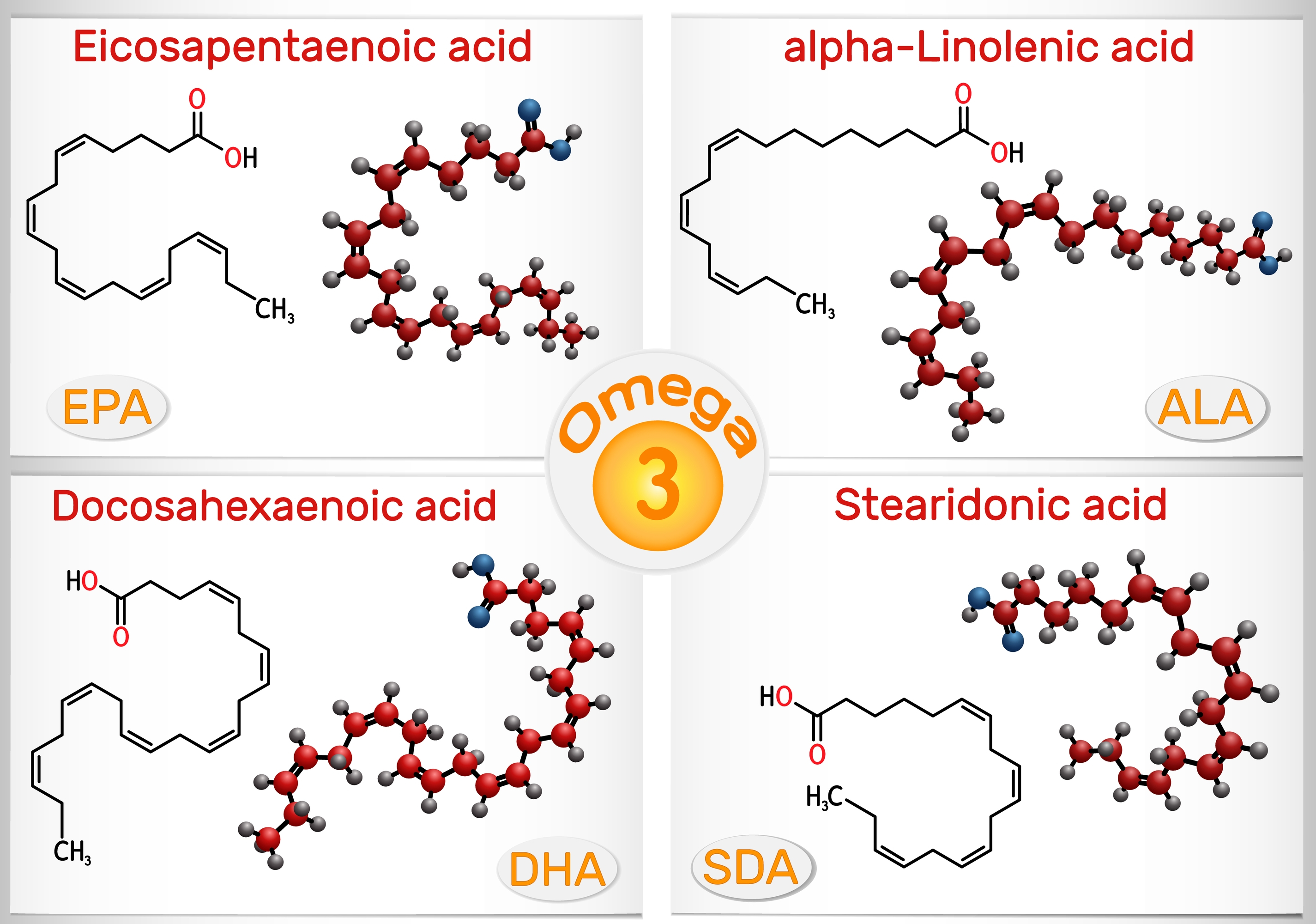
Was sind Omega-3-Fettsäuren?
Omega-3-Fettsäuren zählen zu den essentiellen langkettigen, mehrfach ungesättigten Fettsäuren,
ohne die der menschliche Körper nicht lebensfähig ist. Sie müssen über die Nahrung aufgenommen werden, da unser Körper sie im Gegensatz zu den gesättigten Fettsäuren nicht selbst herstellen kann.
Die wichtigsten Omega-3-Fettsäuren, die vor allem in fettigen Fischen stecken, sind die Eicosapentaensäure (EPA), Docosapentaensäure (DPA) und Docosahexaensäure (DHA). Omega-3-Fettsäuren kommen in pflanzlichen und maritimen Quellen vor.
Die zu den pflanzlichen Omega-3-Fettsäuren gehörende alpha-Linolensäure (ALA) ist für den Menschen ebenfalls essentiell. Sie gilt als Ursprungsquelle, aus ihr entstehen die Fettsäuren DHA und EPA.1 Unser Körper kann aus ALA jedoch nur begrenzt die marinen Omega-3-Fettsäuren EPA und DHA bilden. EPA und DHA kommen in fettem Seefisch, Fischöl, Krill und Algen Öl vor.
Wichtig ist, dass es sich hierbei um Fisch aus Wildfang handelt, da dieser einen höheren Omega-3-Anteil enthält als Fisch aus Aquakultur. Denn Zuchtfische werden zumeist ebenfalls mit Omega-6-reicher Kost gefüttert und halten daher heutzutage kaum noch Omega-3.
Omega-3 wirkt entzündungshemmend und hat einen Gegenspieler, die Omega-6-Fettsäuren, welche entzündungsfördernd wirken. Beide Fettsäuren sollten in einem ausgeglichenen Verhältnis im Körper sein oder mindestens in einem Verhältnis von 3:1. Omega-6-Fettsäuren sind unter anderem im Distel-, Sonnenblumen-, Maiskeim- und Sojaöl, aber auch in tierischen Fetten enthalten.
Abgebaut und umgewandelt werden Omega-3-Fettsäuren in der Leber – dafür sind viele Enzyme verantwortlich, die dafür sorgen, dass die Fettsäuren entweder noch länger werden, indem sie Kohlenstoffatome „andocken“ oder die Fettsäuren noch ungesättigter werden, um sie noch besser in unsere Zellmembranen einzubetten.

Gesundheitliche Vorteile von Omega-3-Fettsäuren
Omega-3-Fettsäuren haben einen vielseitigen Gesundheitsschutz: Vor allem die Omega-3-Fettsäure DHA gilt als wichtiger Bestandteil von Zellmembranen im Gehirn sowie in den Augen, und hält die Funktionsfähigkeit dieser Organe am Laufen.2
Unser Gehirn besteht überwiegend aus Fett. Omega-3 ist Bestandteil von jeder unserer 100 Milliarden Nervenzellen im Gehirn: 30% der Strukturfette im Gehirn bestehen aus DHA, einer Art Omega 3 Fettsäuren. Bei dem hohen Bestandteil ist die Einnahme von Omega 3 Fettsäuren also fördernd und unverzichtbar. Daher ist Omega-3 für die Entwicklung von Gehirnleistung und Sehkraft schon während der Schwangerschaft und für die gesunde Entwicklung des Neugeborenen unverzichtbar.
Darüber hinaus besitzen langkettige Omega-3-Fettsäuren einen schützenden Effekt für Herz und Kreislauf, denn sie stabilisieren den Herzschlag, normalisieren die Blutfette und können den Blutdruck senken.3
Sie sind in der Lage entzündungsfördernde Enzyme zu hemmen und so chronische Krankheiten wie Allergien, Asthma, Rheuma, Arthritis, Neurodermitis und Autoimmunkrankheiten positiv zu beeinflussen.4
Aus diesen Gründen empfiehlt die Deutsche Gesellschaft für Ernährung (DGE) und die Europäische Behörde für Lebensmittelsicherheit (EFSA) eine tägliche Aufnahme von circa 200 mg DHA & EPA (das entspricht 0,5 % der täglichen Energiezufuhr). Dies entspricht bei einer durchschnittlichen Energiezufuhr von 2400 kcal einer Menge von etwa 1,3 g pro Tag, wobei sich diese Angabe im Wesentlichen auf die Alpha-Linolensäure bezieht.5
Wie viel Omega-3 am Tag aufgenommen werden sollte, variiert je nach Alter und körperlicher Kondition bzw. Aktivität.6 Da der Omega-3-Tagesbedarf ist bisher nicht genau bekannt ist, können bislang keine konkreten Zufuhrempfehlungen ausgesprochen und stattdessen nur Schätzwerte definiert werden.

So decke ich die Empfehlung der DGE im Alltag
Fettfische wie Hering, Lachs, Makrele oder Algen sind gute Lieferanten für Omega-3-Fettsäuren. Eine Portion (200 g) dieser Fischsorten sollte daher 1- bis 2-mal pro Woche auf dem Speiseplan stehen.
Wer keine tierischen Produkte zu sich nehmen möchte, kann seine Omega-3-Versorgung stattdessen über Omega-3-reiche Algen erhöhen. Hierbei handelt es sich jedoch um eine andere Omega-3-Fettsäure als bei den marinen Fettsäuren aus Fisch und Algen.
Gute pflanzliche Omega-3 Lebensmittel (reich an ALA (Alpha-Linolensäure) sind Walnüsse, Walnussöl, Leinsamen und Hanföl.7 Wer regelmäßig Walnüsse isst, tut viel für seine Gesundheit - besonders wenn er die Walnüsse statt ungesunder Snacks knabbert. In einer Studie mit 194 gesunden Probanden konnten die Forscher aus München zeigen, dass ein achtwöchiger Konsum von Walnüssen (43 g / Tag – circa 10-11 Stück) die Lipide der Probanden signifikant verbessern kann.8
Quellen
- Vaupel P, Biesalski H. Lipide. In: Biesalski H, Bischoff S, Pirlich M et al., Hrsg. Ernährungsmedizin. 5.,vollständig überarbeitete und erweiterte Auflage. Thieme; 2017.
- Wu, Aiguo, Zhe Ying, and Fernando Gomez-Pinilla. „Dietary omega-3 fatty acids normalize BDNF levels, reduce oxidative damage, and counteract learning disability after traumatic brain injury in rats.“ Journal of neurotrauma 21.10 (2004): 1457-1467.
- H.K. Biesalski, P. Grimm, S. Nowitzki-Grimm. Taschenatlas Ernährung, S. 122, 8. Auflage, 2020, Thieme Verlag
- Kang, Jing X., and Karsten H. Weylandt. “Modulation of inflammatory cytokines by omega-3 fatty acids.” Lipids in Health and Disease. Springer Netherlands, 2008. 133-143.
- DGE (Hrsg.) Referenzwerte für die Nährstoffzufuhr, Neuer Umschau Buchverlag, Neustadt 2008
- Fett, essenzielle Fettsäuren - DGE
- Die Nährstoffe – Bausteine für Ihre Gesundheit. Deutsche Gesellschaft für Ernährung e.V., 6. Auflage, 2022
- Eine mit Walnüssen angereicherte Ernährung beeinflusst das Darmmikrobiom bei gesunden kaukasischen Probanden: Eine randomisierte, kontrollierte Studie - PubMed (nih.gov)